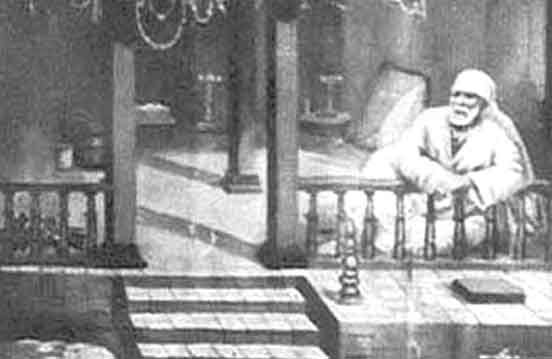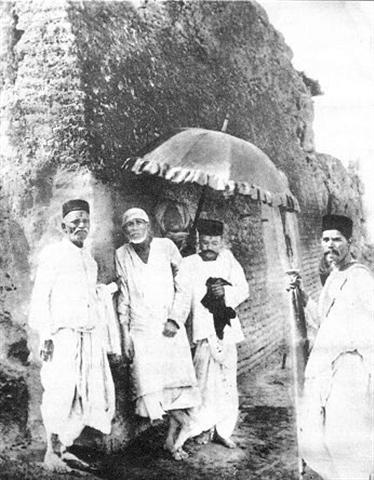About Saibaba
Who is Shirdi Saibaba
Who is Sai Baba? This is not an easy question to answer! Even if we were to assemble all the available information, an adequate explanation is likely to elude us. One might as well ask "what" as much as "who", for how to describe the indescribable? How to explain the inexplicable? And how to speak about the unspeakably mysterious? As G. R. Dabholkar (alias Hemadpant), the illustrious author of the Sri Sai Satcharitra helplessly submitted, "Who can describe Baba's boundless love and his wonderful natural knowledge and his all-pervasiveness?" In fact, here Hemadpant has given us a clue to Baba's identity: for many of his devotees, Baba is an embodiment of love, "boundless love", and once we begin to explore the question of who Baba is, we realize that it is not something to be described, but rather something each of us can experience for ourselves. Then, as Hemadpant says, "Blessed are they who can experience one or all of these!"
Sai Baba is revered as one of the greatest saints ever seen in India, endowed with unprecedented powers and worshipped as a God incarnate. This mysterious being, who arrived unannounced in Shirdi as a youth and remained there throughout his long life, transformed the lives of those who met him and continues to do so for those whose hearts are touched by his love.

Baba stated that his mission is to "give blessings" and he proves it in myriad ways: healing the sick, saving lives, protecting the vulnerable, averting accidents, granting offspring, facilitating financial gain, bringing people into harmony with themselves and each other and, above all, in effecting the spiritual evolution and transformation of those who come to him. Baba is, as one of his contemporary devotees put it, "the embodiment of the Supreme Spirit, lighting the sadhakas' path by his every word and action." To his devotees, Baba is nothing less than God. An outstanding aspect of Sai Baba is that he is beyond distinctions of religion, caste or creed. Some believe him to be Hindu, others see him as a Muslim. He embodied all religions yet was free from all strictures. Hindus and Muslims find their meeting point in Sai, and people from all communities and all walks of life are united by the great love and reverence Baba inspires in them. "I look on all with an equal eye," said Baba, and he would brook no dispute or religious bigotry among his disparate devotees. As Sri Babuji observes in Arati Sai Baba, "Not identifying in totality with any religious community, by steering himself along an unbiased middle path of transcendence, seems to be the constant leitmotif of Baba's lifestyle. The popular notion is that Baba expressed himself as a Hindu to Hindus and as a Muslim to Muslims. However, in most cases Baba acted vice versa, insisting that the Hindus should accept him as a fakir and the Muslims as a Brahmin!" Hindus could claim Baba as their own as he responded to their needs and permitted worship according to their rituals, but they could not deny the fact that his dwelling place was a mosque and the name of Allah was ever on his lips. As for Sai Baba’s style of teaching, he did not deliver lectures and rarely gave formal teachings. Rather, he taught by parable, direct experience, and the example of his own life. Baba's way is to cater directly to the needs of each individual and he did not require his devotees to take up any rituals or conventionally prescribed practice, nor did he favour any particular path over another. Baba generally discouraged people from changing their chosen form of worship. Indeed, once when a Hindu devotee converted to Islam, Baba slapped him and exclaimed, "What! You have changed your father?" The Sri Sai Satcharitra (Ch. 19) reveals an inkling of the infinite variety of methods that Baba used to "teach" his devotees. "Sometimes Baba observed a long silence which was, in a way, his dissertation on Brahman; at other times, he was Consciousness-Bliss incarnate, surrounded by his devotees. Sometimes he spoke in parables, and at other times, indulged in wit and humour. At times, he was quite unambiguous; and at times he seemed enraged. Sometimes he gave his teachings in a nutshell, at other times he argued at length. Many a time, he was very plain. In this way, he gave varied instructions to many, according to their requirements." In everyday life, Baba never missed an opportunity to point out something that would benefit an individual's evolution. This could come in the form of direct instruction, or devotees might be put in circumstances where they were forced to realize something: "Like a loving mother forcing bitter but wholesome medicines down the throats of her children for the sake of their health, Sai Baba imparted spiritual instructions to His devotees." (Ch.11) Baba's "teachings" sometimes appear contradictory, but this is because it was tailored to what a particular individual needed at a particular time. Thus sometimes he would encourage the reading of specific scriptures, but at other times, also sitting quietly; sometimes doing japa, but also ceasing to do japa; activity in the world, but also temporary withdrawal from it; puja to one's ishtadevata (chosen deity) and kirtan (including namasaptaha - singing God's name continuously for seven days), but on other occasions he would show that there was no need for such things, and so on. There are also several instances recorded of Baba reinforcing a devotee's faith by manifesting to them in the form of their ishtadevata. Above all, however, Baba taught through an experience of love. The limitless love he extended to his devotees was reflected in their loving devotion and dependence on him. Baba spoke memorably about the great love between himself and his own guru; it was indescribable, he said, all-compelling, and filled them both with unsurpassable bliss. It is this powerful emotion that Baba triggers in his devotees, which then becomes the basis for all his teaching. Thus, more than anything else, Baba advocated trust and dependence on the sadguru, who, he repeatedly said, would take care of everything. Baba's love and protection was such that it is often described as "motherly". The written experiences of the devotees and even the arati songs abound with joyful references to this; Baba also often spoke of his "children". As Sri Babuji wrote in Arati Sai Baba, "If we are to sum up Sai Baba's life, it is the spontaneous overflow of bounteous grace, in the form of spiritual and temporal well-being, inundating those who take refuge in him." For Sai Baba not only guided spiritual aspirants to the final destination, but he also looked compassionately on those seeking fulfilment of worldly desires. He is the epitome of Sri Babuji's statement that "the sadguru is the bridge which fuses the spiritual with the material". Once when a devotee objected to people going to Baba only for temporal benefit, Baba rebuked him, saying, "Don't think like that! That's what my people come to me for! First they get their desires fulfiled, then once they are comfortably placed in life they follow me and progress further." In what has now become a famous adage, he once said, "I give my devotees what they ask for until they ask for what I want to give." To this day, examples proliferate of how Baba is daily catering to the needs of the millions who worship him. They give us a small glimpse of Baba's unique greatness - his omniscience, omnipresence, his divine identity - and his overflowing love for all beings.
Sai Baba’s Daily Routine

